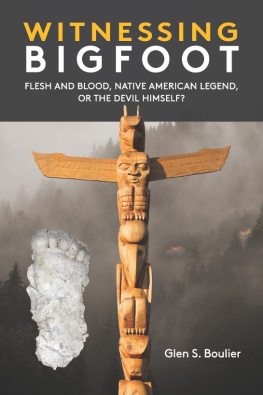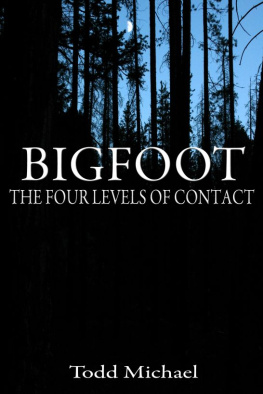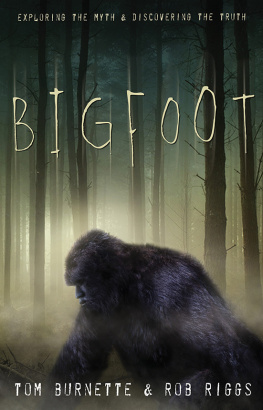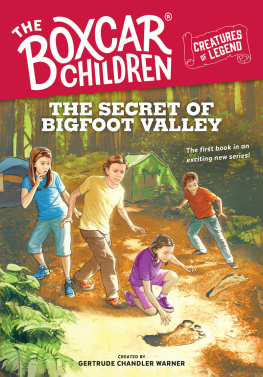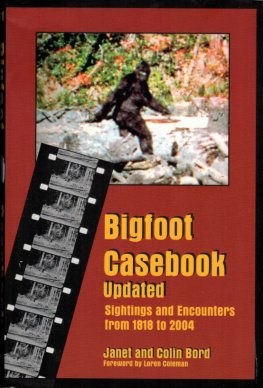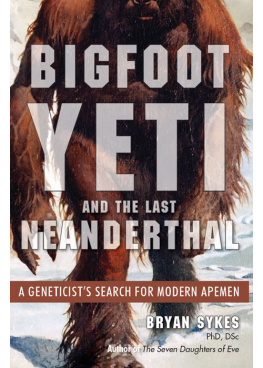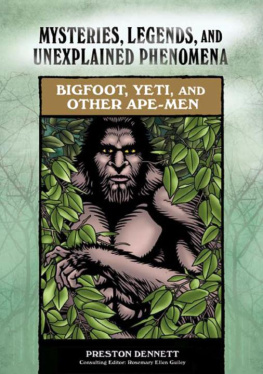Gisondi, Joe.
Monster trek: the obsessive search for Bigfoot / Joe Gisondi.
Includes bibliographical references.
ISBN 978-0-8032-4994-3 (pbk.: alk. paper)
1. SasquatchUnited StatesAnecdotes. I. Title.
QL 89.2. S 2 G 57 2015
The publisher does not have any control over and does not assume any responsibility for author or third-party websites or their content.
for making family life the best adventure of all.
Than are dreamt of in your philosophy.
Thats the trouble with losing your mind; by the time its gone, its too late to get it back.
To alter a pervasive sports metaphor, theres no I in book (although there is justifiably one in bigfoot). Yet there is an I in this book. As a journalist, I have been taught to remain neutral, report the facts, and rely on quoted material good advice to a point. But this is not that kind of book. At first, I fought against inserting myself into this story, arguing that this narrative is about people who search for bigfoot. Eventually I realized (thanks in large part to Dianne Apriles constant encouragement) that every story needs a guide, and thats the role I serve in this book. Like those who search for bigfoot, we all need to expand our perspectives and to take risks. This book, I hope you agree, is enriched by this approach. I have been blessed by having so many people besides Dianne serve as mentors through this project Nancy McCabe, who helped me develop the opening chapters; Roy Hoffman, who helped me move in a new direction; Richard Goodman, who opened up a whole new approach to writing; and a community of supportive friends and teachers in Spaldings MFA program.
Of course, theres no way I could have completed this project without so many bigfoot investigators bringing me into their confidence, sharing personal stories and thoughts, and allowing me to traipse through woods, mountains, and swamps to follow them in their endeavors. I hope this book treats everyone as respectfully as they very well deserve. Thanks, in particular, to Harold Benny, Donna Cohrs, Melissa Hovey, Don Keating, Jeff Meldrum, John Mionczynski, Matt Moneymaker, Tommy Poland, Pat Rance, Carolanne Solomon, Billy Willard, and Don Young.
Thanks also to Eastern Illinois University for allowing me the time to work on this project and to colleagues who constantly offered support and encouragement.
Thanks more than anything to my wife, Betsy, and to my daughters, Kristen and Sarah, who carried the biggest burden of living with a writer whose mind constantly ventured, whose body constantly sat in an office writing, and whose psyche sometimes zagged. Without you all, none of this matters.
Believing in bigfoots a matter of faith.
Let me confess: I dig reading about the paranormal ghosts flitting around old homes, chupacabras sucking the blood of goats and chickens in Puerto Rico, Nessie eluding searchers in a Scottish loch, UFO s soaring through western skies. Whats not to enjoy? I devoured these stories with millions of other Americans as a kid. I also learned that explorers like Admiral Byrd descended into middle earth from openings found in Antarctica and that lycanthropic people shape-shift into werewolves under a full moon. Did a large, hairy, man-like creature living deep in the Pacific Northwest woods scare hikers, abduct campers, and topple tractors sent to destroy its homeland in Northern California? Duh.
These stories all seemed real, especially to a ten-year-old kid reading them in a newspaper tossed on the coffee table right next to the Newark Star-Ledger, the New York Daily News, and the Bridgewater Courier-News. How could I not believe? How was any of this crazier than the stories in the Star-Ledger about men killing store clerks over fifty bucks? Or articles about gangs that raped young girls in the Bronx? Or even politicians taking bribes for favors despite what I had just read in my fourth-grade history texts? The Founding Fathers would have rolled over in their graves. (Actually, that may have been a story in the National Enquirer. Cant recall.) None of these news stories seemed more bizarre than those described in the more mainstream newspapers, not that I knew the difference back in elementary school.
I blame my mom, of course. Its always easier to blame ones parents for flaws revealed in adulthood. After all, my mom was the one whod casually grab the National Enquirer at the cash register, tossing it onto the conveyor along with the canned green beans, ground beef, and Super Sugar Crisps each week. At home, shed spend days reading it on the couch, just like she did the other newspapers. So when shed make dinner or vacuum, Id put down the sports section and the comics to sneak it up into my room the same way my friends pilfered Playboy. Upstairs in my room, Id read features about the real-life ghost story of the month, check updates on the Missouri Monster, known as MoMo, or determine where aliens had recently abducted my fellow Americans (like Betty and Barney Hill, who had not recalled the probing by small humanoid figures until they were hypnotized!).
In 1973 I had not yet learned that aliens preferred to snag people from trailer parks and rural southern homes. But, doggone it, that seemed to be the case in the Enquirer. That same year, Hollywood started producing TV documentaries about Erich von Danikens books like Chariots of the Gods?, which purported that space travelers in ancient times inspired many religious ideas about God and angels a shocking hypothesis for an impressionable Catholic kid. But enquiring minds, like me and my mom, wanted to know the truth. We couldnt help ourselves. The truth was out there.
As I said, none of this seemed crazier than other reports in the news. In 1974 the president of the United States resigned from office for lying and cheating something that could get you kicked off our Little League baseball team or sent to the principals office. What could be more bizarre than that? That more than fifty people reported seeing a large, hairy beast wondering in the woods that same year? Please. Besides, to an eleven-year-old, the woods seemed much more mysterious and foreboding, especially after reading reports in the paper.
By 1976 I was watching In Search of... , a TV show that documented investigations into the paranormal by showing reenactments, interviewing experts, and offering scientific explanations. Actor Leonard Nimoy, the ever-logical Spock, narrated each show laconically, stating facts as unceremoniously as Walter Cronkite did on the CBS Evening News. That summer I also watched the documentary The Legend of Bigfoot at the historic Brook Theater in Bound Brook, New Jersey. Thats where I saw this mythic creature for the first time (or, should I say, bigfoot looked directly at me) in the infamous Patterson-Gimlin film. Needless to say, I no longer walked alone through the woods to Adamsville Middle School after that.
Even my father, a decorated Korean War veteran, piled on, telling me stories about people seeing the Jersey Devil not far away, in the Pine Barrens of southern New Jersey. My dad, who owned a pool company, sometimes heard bigfoot accounts from clients across the state. But thats not a surprise. Bigfoot are reported across all social, educational, and economic classes. Despite popular opinion, sightings are not just reported by gullible, lazy rednecks with little intelligence (and far fewer teeth). Witnesses include police officers, office managers, lawyers, business vice presidents, soldiers, housewives, teachers, and kids. Most witnesses have nothing to gain, but a great deal to lose. Some witnesses have had their lives turned upside down, ridiculed by neighbors and coworkers for admitting they may have viewed something.


